The Noble Savage at the Electric Fountain
Topic: Landmarks
| The Noble Savage at the Electric Fountain |
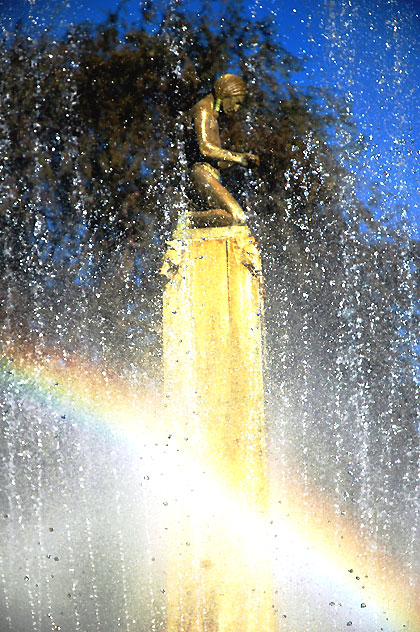 On the northwest corner of Wilshire and Santa Monica Boulevards there's the Beverly Hilton Hotel, from 1955 and now all remodeled, with Trader Vic’s attached (the place that invented the Mai Tai and other girly drinks with the little paper parasols, and still offers that taste of the fifties, an Americanized version of what Polynesian food might be like if you never left Iowa and made it all up). On the southwest corner, across from a Starbucks that used to be leather shop where you could get a suede bomber jacket, there's Creative Artists Agency (CAA) - a big white whale of a building by Richard Meier, that fellow who did The Getty Center. It's full of major Hollywood agents, of course. On the southeast corner is the parking lot of the Beverly Hills Budget Rent-a-Car folks. Yes, you can rent a Rolls or Ferrari or Lamborghini out here. They’re all lined up there.
On the northwest corner of Wilshire and Santa Monica Boulevards there's the Beverly Hilton Hotel, from 1955 and now all remodeled, with Trader Vic’s attached (the place that invented the Mai Tai and other girly drinks with the little paper parasols, and still offers that taste of the fifties, an Americanized version of what Polynesian food might be like if you never left Iowa and made it all up). On the southwest corner, across from a Starbucks that used to be leather shop where you could get a suede bomber jacket, there's Creative Artists Agency (CAA) - a big white whale of a building by Richard Meier, that fellow who did The Getty Center. It's full of major Hollywood agents, of course. On the southeast corner is the parking lot of the Beverly Hills Budget Rent-a-Car folks. Yes, you can rent a Rolls or Ferrari or Lamborghini out here. They’re all lined up there.
That leaves the northeast corner of the intersection, where there's a fancy fountain, with a sculpture of a noble savage, an Indian, or Native American if you will. The figure sits atop a plinth in the middle of the fountain, continually soaked by the waters. This whole affair is from 1931 - a far more innocent time. It seems to be a celebration of something pre-Hollywood, the days when this really was "the West" and there were real Indians and covered wagons and all the rest - long ago, before John Ford directed John Wayne in the fake version.
This is the Electric Fountain. The plaza and fountain are the work the architect Ralph Carlin Flewelling, and the sculpture is by Robert Merrell Gage. The park surrounding it all was given to the city by the Beverly Hills Residential Protective Association. It was 1931 and the Great Depression was on. It provided something to feel good about - the history of the taming of the West and all.
As for the fountain - Electric fountain is said to have stopped traffic for hours when unveiled in 1931 (quoted in "Fountain Blues", New West, April 25, 1977). Originally, the Fountain's water jets and color effects were timed to give 60 different combinations every 8 minutes. Total cost of the Fountain was $22,000, $8,000 of which was spent for electrical equipment and wiring (from "Request for Determination of Eligibility for Inclusion in the National Register of Historic Places," prepared by Lois M. Webb and George Casen, p.2. also see Jennifer Ring, "Splash and Spray Around LA; A Tour of Some of the City's Classier Spouts," Westways, September 1972).
It is still rather spectacular.
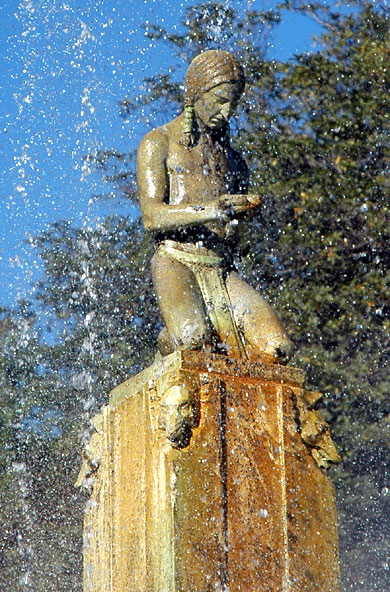 Then there's Robert Merrell Gage -
Then there's Robert Merrell Gage - Gutzom Borglum, the man who carved the famous figures on Mount Rushmore, called Robert Merrell Gage "that steady-eyed young sculptor," and from those steady eyes came a vision of art that spoke of strong values, American values, Kansan values. An alumni of the most sophisticated art schools, Robert Merrell Gage turned for subject matter to the basics of American history, the stories of the western struggle and the lives of heroes of the American soul.
Gage was a native Topekan, born in 1892, and educated in the Topeka public schools and at Washburn College. He left Kansas after graduation to study sculpture in both New York and France with Borglum and Robert Henri, two exponents of the "American Theme" in art. Returning to Topeka in 1916, the young sculptor set up shop in a barn behind his house on Fillmore Street and began his first public commission, the magnificent statue of Lincoln that rests on the Kansas State Capitol grounds. After a stint in the armed services during World War I, Gage began a teaching career at Washburn and at the Kansas City Art Institute. In 1924, Gage left the Midwest for a position at the University of Southern California, a post he held until his retirement in 1958.
The winner of many awards and honors, Robert Merrell Gage left behind a large and excellent body of work when he died in 1981. His interests were many and they were reflected in the materials he worked with-stone, wood, metal, and clay-as well as his format, which ranged from portraiture to architectural sculpture. But his subjects consistently expressed major American themes. Among his better known works are his "Pioneer Mother Memorial" situated a short distance from his Lincoln statue at the Kansas State Capitol, his busts of Walt Whitman and John Brown at the Mulvane Art Museum, his "Police Memorial" and "Veterans' Fountain" in Kansas City, and his "History of California" frieze in Beverly Hills.
Deeply impressed by the writings of Walt Whitman and the example of Abraham Lincoln, Gage portrayed and interpreted the freedom and dignity of the American experience through the medium of his art. Some have called him, and, indeed he was, "the American sculptor."
Native Americans may be offended now by the patronizing and imperialistic tone of much here, but this was 1931, and the benign American myth of exactly what had happened was still strong.
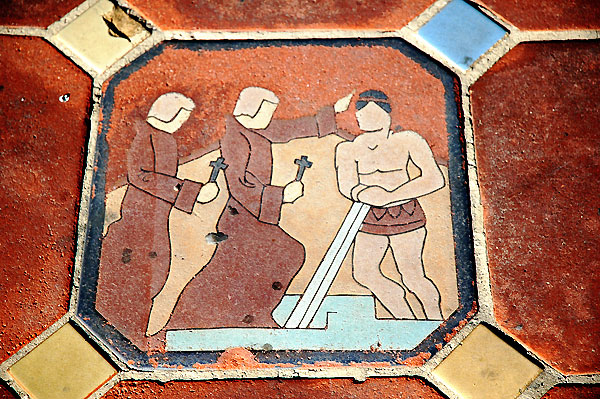


Up on the roof...
Topic: Landmarks
Around six-thirty in the evening, Sunday, September 10, 2006 - Sunset on Sunset - the Directors Guild of America building with the La Brea apartments in the flats below, the corner of Sunset and Laurel with the Laugh Factory and all, and looking the other way, the view out across Hollywood at Griffith Park Observatory - shot from the roof here - 
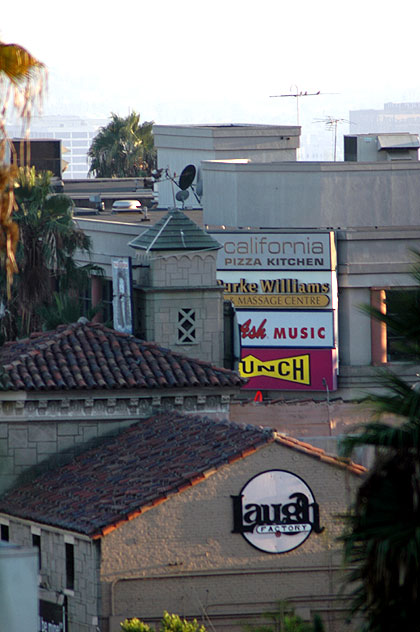

Movie Madness
Topic: Landmarks
Movie Madness

They take movies seriously down in Culver City, and just across the street from old MGM studios - home to The Wizard of Oz and An American in Paris and all the rest, but now Sony-Columbia - at the Veterans Memorial Building there's this stainless steel thing in the reflecting pool out front - "Filmstrip USA" by Natalie Krol. It was installed in 1981, the year after they renovated the brutal 1950 building behind it. That's still ugly, but at least it is now neat and clean - anonymous fifties public buildings aren't very interesting.
The sculpture, or whatever this thing is, is amusing. Stainless steel film stock?
But this is, after all, The Heart of Screenland - Hundreds of movies have been produced on the lots of Culver City's studios, including The Wizard of Oz, The Thin Man, Gone with the Wind, Citizen Kane, Rebecca, the Tarzan series, and the original King Kong. In fact, the Yellow brick road from The Wizard of Oz is still inside the lot on Stage 27 of Sony Studios. More recent films made in Culver City include Grease, Raging Bull, E.T. the Extra-Terrestrial, City Slickers, Air Force One, Wag the Dog and Contact. Television shows made on Culver City sets have included Las Vegas, Mad About You, Lassie, Batman, The Andy Griffith Show and Jeopardy!.
John Travolta's "Stranded at the Drive-In" sequence in Grease was filmed at the Studio Drive-In on the corner of Jefferson and Sepulveda. It served as a set for many other films, including Pee-wee's Big Adventure.
... Culver City's streets may be familiar to many movie-goers. They have been featured in countless films and television shows. Since much of the architecture of the residential areas of the town has not changed in decades, the nostalgic sitcom The Wonder Years set many of its outdoor scenes in the timeless neighborhoods of Culver City. The 1970's show CHiPs also featured many chase scenes through the streets. The Nicholas Cage film Matchstick Men included scenes made at Veterans Memorial Park (which was also featured in the opening scenes of the sitcom Valerie / Valerie's Family / The Hogan Family).
The history of the town is beginning to be recognized. The Aviator, a 2004 film about Howard Hughes, featured several mentions of Culver City in connection with Hughes. The Hughes aircraft plant had a Culver City mailing address but was actually in the adjacent Los Angeles neighborhood of Westchester at a site now called Playa Vista.
So this work makes sense, of course.
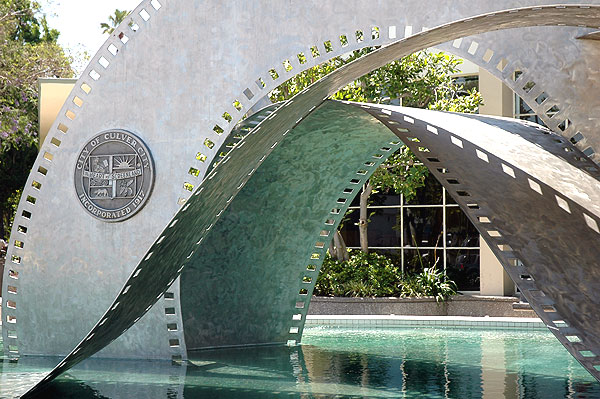
Personal Note - lived in Culver City in the early eighties, saw a bad movie or two at that Studio Drive-In with the wife, but it's now gone and there are overpriced little houses where it stood, and at the time worked at Hughes down in Playa Vista, and listened to my father-in-law when he visited from the Pentagon tell tales of being part of the Citizen Kane production way back when (he went to high school with Orson Welles) - very odd -
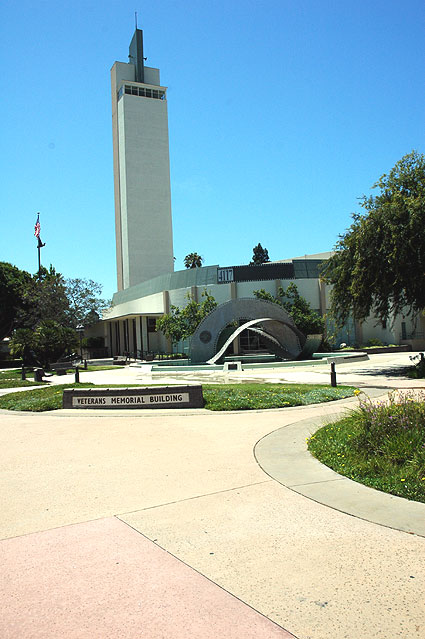
The Hollywood Tourist
Topic: Landmarks
The Hollywood Tourist

The weekend begins on Hollywood Boulevard - some shots from Friday afternoon, June 16, 2006.
What is this crew doing across the street from Grauman's Chinese Theater? They didn't want to be bothered. They were busy. It's Hollywood. And it's a classic candid shot.
And here's some weekend tourist stuff.
See below. Grauman's is famous for the collection of handprints, footprints, and autographs in the theater's courtyard - two hundred movie folk have put their hands or feet or whatever in the cement there. As for whatever, you can find the imprint of Harold Lloyd's glasses, the cigar-print of the cigars of Groucho Marx and of George Burns - and Betty Grable's legs, John Wayne's fist, and Al Jolson's knees. There are two nose prints - Jimmy Durante and Bob Hope. William S. Hart and Roy Rogers left imprints of their guns, and there are hoof prints - Tom Mix's "Tony," Gene Autry's "Champion," and of course Roy Rodgers' "Trigger." It's a very odd place. But Sid Grauman was a showman.
This has been going on since 1927, and, should you be in town, this might be useful - a clickable map of the courtyard so you can find what interests you, if any this does.
And you might also remember the end of Mel Brooks' Blazing Saddles -Hedley Lamarr is driven to Grauman's Chinese where the marquee flashes the current film "Blazing Saddles." To hide and escape from Bart, he pays for one full admission to the film after failing to convince the attendant that he is a student. A female tourist remarks to her husband as she tries out the footprints of actress Hedy Lamarr - "Look, Herman, I'm in Hedy Lamarr's shoes!" - Hedley corrects her as he passes by: "Hedley." In the lobby of the theatre are noisy, bleating cattle as he purchases Raisinettes at the candy counter.
As the film begins to play with the familiar opening song, Lamarr suddenly realizes that he is going to be viewing "Blazing Saddles" and he exits in disgust. Outside, he is outdrawn in a gunfight with Bart and shot in the groin. As Lamarr falls and dies in front of the theatre, he studies the cement imprints (hand and feet) of Douglas Fairbanks - "How did he do such fantastic stunts with such little feet?"
He lands in fresh cement - before he expires, he scratches out his own name followed by a dollar sign in the wet cement for his own epitaph. Bart and the Waco Kid enter the theatre to see the end of the film, both wishing for a happy ending.
Yeah, it's sort of an inside joke, a Hollywood thing.
Check out these.
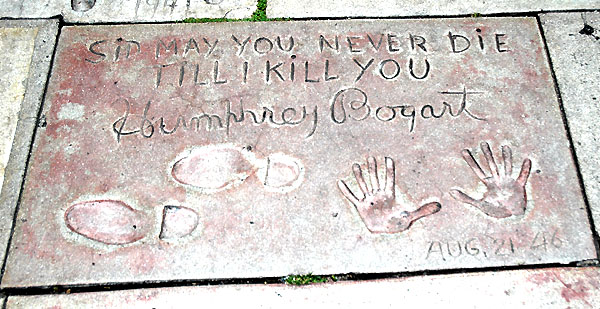

And for what's playing at the Chinese this weekend, it's certainly not "Blazing Saddles" - and it's not Chinese. But it is Asian, sort of. One of the cars from the film was on display in the courtyard, the front bumper just above Fred Astaire and Ginger Rodgers. But you couldn't get near it with all the thirteen-year-old boys checking it out. Ah well. Times change.
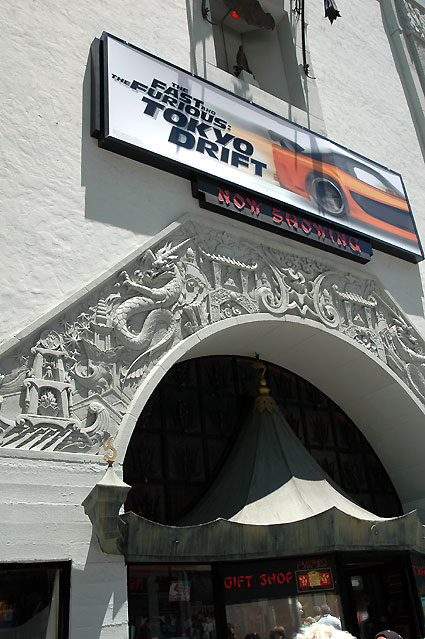
Landmarks: Things Not To Do In Los Angeles
Topic: Landmarks
Landmarks: Things Not To Do In Los Angeles
One thing not to do when visiting Hollywood is stop here for an Oki Dog. It looks harmless and a bit picturesque, so very California, and it's famous in a way. When Oki Dog was at Santa Monica and Vista it was the place in the late seventies for the punk rock crowd, near the clubs and where the big names in the bands stuffed their faces just before dawn after the last set. It was legend. It's been moved west to Fairfax, north of Melrose. And now it's just scary. See the text below the picture.
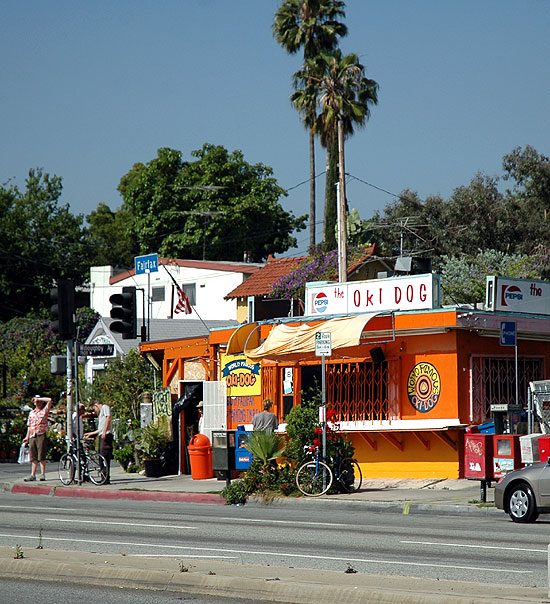
There is a site devoted to America's hot dog stands, and about Oki Dog they offer this (and more) -
Hands down, the weirdest hot dog in LA
Occasionally, you run across a concept that is so alien, so removed from anything you've ever experienced before, that you just don't know what to think about it. Oki Dog is that sort of place. Using the standards we normally apply to rate hot dog stands, Oki wouldn't even register a single dewclaw of a dog on our Dog Rating scale. The dogmeat is chewy and bland, the chili is very cheap, and the atmosphere is akin to eating in a grimy gas station restroom in the middle of the Mohave Desert. This place is a "dive among dives." But we have to admit, we kinda like the place. The whole is greater than the sum of its parts.
... Oki Dog used to be on Santa Monica Boulevard at Vista, right in the middle of "Boystown," where shirtless young gentlemen can be found on every corner "looking for rides." Since it was close to the Hollywood nightclubs and always open late, it developed quite a following among the punk rock movement. Skinheads, longhairs and mohawks could be seen sitting side by side on the stools chowing down on greasy burritos at all hours of the day and night. It was a real happening place back in the late 70s. We don't really know why, but it never occurred to us to stop in and try the place back then.
Well, the neighbors complained about the unruly mob that hung out there, so the City Council banished Oki Dog to a small hut off the strip on Fairfax. A more respectable chain restaurant with pre-fab food and lots of security guards took Oki's spot on Santa Monica and Vista. If Oki Dog could be said to be on the skids before, this development put it face down in the gutter. Today, many ex-Punks who went on to become accountants and lawyers have fond memories of late nights at Oki Dog. As they drive by their old hangout in their shiny new Beemers or Audi station wagons, they roll their windows up tight, lock the doors and shed a quiet tear for what used to be. But the amazing thing is, Oki Dog isn't just a memory. It still exists. The hut is just the same, albeit a bit more battered around the edges. The food hasn't changed - it was always battered around the edges. The battered people who eat there haven't changed much either. Oki Dog LIVES!
It should be noted the whole area, from where it used to stand to the new location, is both heavily Jewish and the heart of the Russian immigrant community here, so pastrami burritos are a specialty - fried pastrami, sautéed cabbage, onions and peppers, mustard and pickles, and a healthy dose of Oki chili. And Oki chili seems to be whatever canned stuff they can find discounted by any restaurant supply wholesaler.
In Japanese, oki means big. And the place seems to be a nod to the many Japanese out here from Okinawa. But the connection is tenuous at best, as noted here -The dish in question is the eponymous Oki Dog. It is massive and terrible to behold. Start with two hot dogs, boiled into rubbery submission, a corpse of a corpse. Add perfect squares of shining American cheese, and bury them in predigested-looking canned chili. Then, the pastrami. A slab of gristly pink pastrami joins the grease mound, and everything is wrapped in a massive tortilla, a tortilla upon which the face of Jesus will never appear. The face of Elvis, perhaps, but not Jesus.
If someone could maneuver a punch down your throat and into your stomach, the experience would be something like eating an Oki Dog, provided your assailant's fist was sufficiently salted. The bundle of fat and low-grade protein simultaneously satisfies all appetite while insulting all aesthetics.
And that's putting it kindly.
As for a "real" Oki Dog, the Honolulu Star-Bulletin offers you this -The Oki Dog is apropos of nothing. A non sequitur. The sum of incongruent parts that add up to Okinawan audacity.
An Oki Dog begins with a hot dog (any type, but red is aesthetically best), a dollop of chili (must be from Zippy's, founded by the Okinawan Higa family), a few slices of shoyu pork (this is what truly makes it Okinawan), shredded lettuce (iceberg, for crunch), wrapped in a flour tortilla (for ease of transport).
And as if all that's not enough: "It would taste good with mayonnaise, but that spoils too quickly," says Isaac Hokama, one of those responsible for bringing the Oki Dog to Hawaii.
Consider it an example of four-part fusion: American/Mexican/Tex-Mexican/Okinawan. Or consider it inexplicable.
Of course that sound a little better.
But the legend of the place lives on. There is a Japanese-based post-punk garage band named Oki Dog, and they chose their name in homage to the West Hollywood hot dog stand that used to be. If you like that sort of music you can listen to one of their cuts here, but that's not recommended.
When the band appeared in London they were described this way - "Oki Dog are an eclectic Noah's Ark of a band: a Pakistani drummer (Kemikal Ali), guitarists from England and Germany (Flip X and Kennedy), a Spanish bass player (Hugo Santacruz) and fronted by a cheeky Chinese lass called Grace. They're a good looking band, oozing artfully crafted cool, who play an energetic, punky Rock Pop, full of sexy licks and catchy riffs."
Yeah, sure. They are the sonic counterpart of the signature Oki Dog, the musical equivalent of the perhaps the worst cheap junk food yet devised.
But all this is Hollywood, after all.
 On the northwest corner of Wilshire and Santa Monica Boulevards there's the Beverly Hilton Hotel, from 1955 and now all remodeled, with Trader Vic’s attached (the place that invented the Mai Tai and other girly drinks with the little paper parasols, and still offers that taste of the fifties, an Americanized version of what Polynesian food might be like if you never left Iowa and made it all up). On the southwest corner, across from a Starbucks that used to be leather shop where you could get a suede bomber jacket, there's Creative Artists Agency (CAA) - a big white whale of a building by Richard Meier, that fellow who did The Getty Center. It's full of major Hollywood agents, of course. On the southeast corner is the parking lot of the Beverly Hills Budget Rent-a-Car folks. Yes, you can rent a Rolls or Ferrari or Lamborghini out here. They’re all lined up there.
On the northwest corner of Wilshire and Santa Monica Boulevards there's the Beverly Hilton Hotel, from 1955 and now all remodeled, with Trader Vic’s attached (the place that invented the Mai Tai and other girly drinks with the little paper parasols, and still offers that taste of the fifties, an Americanized version of what Polynesian food might be like if you never left Iowa and made it all up). On the southwest corner, across from a Starbucks that used to be leather shop where you could get a suede bomber jacket, there's Creative Artists Agency (CAA) - a big white whale of a building by Richard Meier, that fellow who did The Getty Center. It's full of major Hollywood agents, of course. On the southeast corner is the parking lot of the Beverly Hills Budget Rent-a-Car folks. Yes, you can rent a Rolls or Ferrari or Lamborghini out here. They’re all lined up there.  Then there's Robert Merrell Gage -
Then there's Robert Merrell Gage - 














